Standard of SCAA pecialty Coffee Fine Coffee Raw Bean
[SCAA "Specialty Coffee" standard for high-quality coffee raw beans]
The raw bean defects of SCAA can be divided into two types: type I and type II.
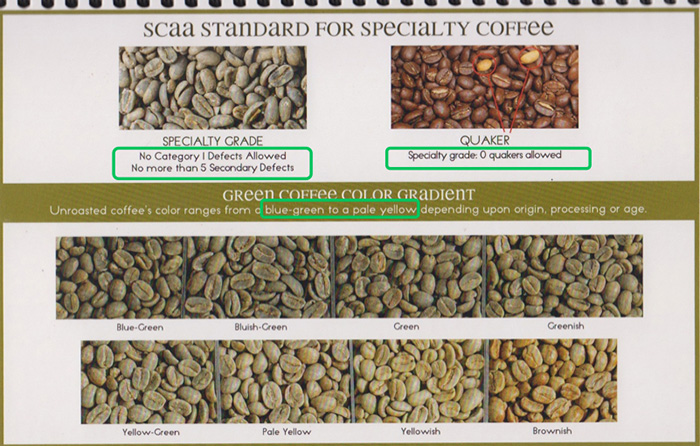
The requirement for boutique coffee (specialty coffee) is:
1. No Class I defects;
two。 No more than 5 II class defect
3. There can be no "quaker" (0 quaker) Quick beans in cooked coffee beans.
4. The color range of raw coffee beans is pale yellow (light yellow), yellow-green (yellowish green), greenish (partial green), green (green), bluish-green (bluish green) and blue-green (blue green). The color of raw coffee beans defined by SCAA can be divided into brownish light brown, yellowish yellow, pale yellow light yellow, yellow-green yellow green, greenish green, green green, bluish-green bluish green, blue-green blue green, (among them, lighter yellowish yellow and brownish brown can not be used as specialty grade boutique grade).
5. No smell, .
[grading standard]
The sample quantity is: raw bean 350g, cooked bean 100g.
Defect standard
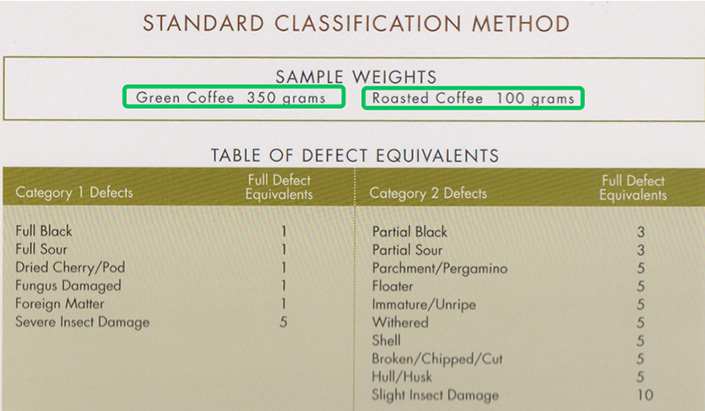
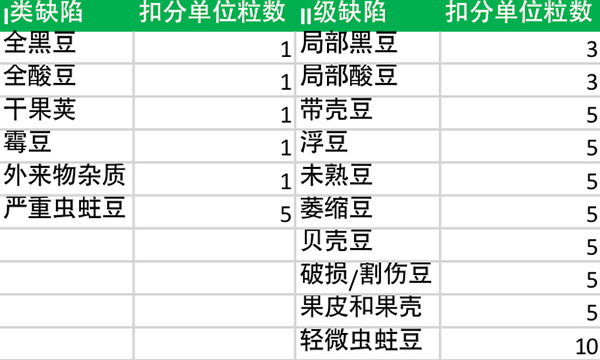
One thing to note here is:
The number of particles per unit deducted by Full Defect Equivalents satisfies different conditions for different defects. (for example, for a full black bean, one is counted as a Class I defect, and two as two Class I defects; serious moth is counted as five per unit, and if less than five are not counted as Class I defects, if five or more than five but less than 10 are found, it is counted as a Class I defect, and so on. Among the II defects, the local acid or local black bean is 3 units, while the slight moth is 10 units, and the rest is 5 units.
Moisture content: it is mentioned here that the water content of coffee treated by washing is between 10% and 12%.
The size of beans: this means that the size of the beans cannot exceed 5% of the contract specification;
Baking consistency: based on 100g sample baking standard, there can be no quaker (Quick beans).
Graded supplementary note: if two or more defects occur at the same time, the more serious ones will be dealt with. (for example, if there are local sour beans, but there are also 2 wormholes, then the defects must be classified as local sour beans.)
Flavor characteristics: in the cup test of the sample, beans should be able to show the flavor characteristics of the producing area, including dry and wet aroma, acidity, mellow thickness, aftertaste (aftertaste) and overall characteristics.
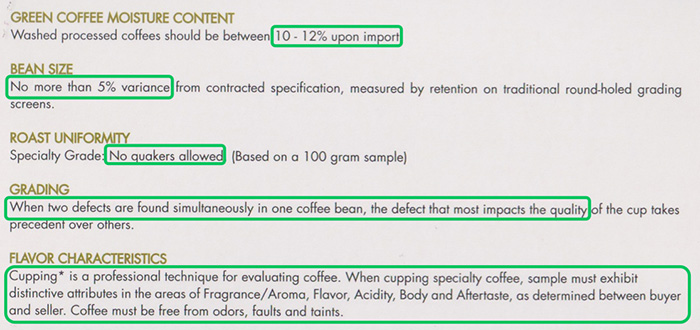
The following is a single description of each defect (Class I and Class II).
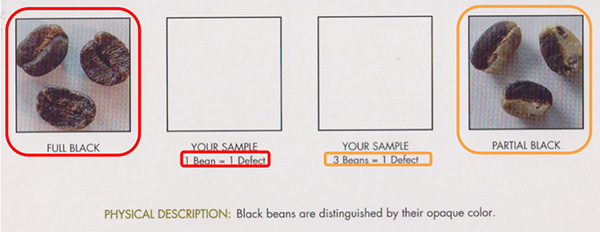
[black beans]
Physical characteristics of : the most prominent feature of black bean is its opaque black .
Classification and defect score: black beans are divided into total black beans and local black beans according to the proportion of black beans in the whole coffee bean. (the difference between total black and local black: if the black area is less than half of the bean body, it will be treated as a local black bean, otherwise it will be treated as an all-black bean.)
1 full black counts as a Class I defect .
Three local blacks count as an II defect
Effect on the taste of the cup: SCAA describes an uncomfortable fermentation or odor, dirty, moldy, sour and phenolic smell. What I used to drink was a disgusting, uncomfortable sour and bitter smell, as well as the smell of phenol, like hospital disinfectant.
Other problems: octreotide A, which is harmful to the liver and kidneys, has been reported to degrade 80% of the toxin after baking (200 degrees Celsius), but pick it out as much as you can.
Cause of defect: this kind of defect is produced in planting, and there are many causes.
Due to infection by an organic pathogen, Colletotrichum coffeanum. The origin was found in Africa. At present, there are also cases in Central and South America.
Insufficient water supply of coffee fruit during ripening period, which affects plant metabolism of
Picked unripe beans are dried at high temperature (above 30 degrees Celsius)
Avoid and improve:
Planting: select ripe coffee fruits, improve the farming environment and methods, avoid creating a suitable environment for Colletotrichum coffeanum, improve ventilation, and clean up the stagnant water around coffee trees in a timely manner.
Treatment: black beans (after shelling) are smaller and lighter than normal beans, so black beans can be screened out by size screening and specific gravity screening in post-processing, and the most effective way is hand selection (the color of black beans after parchment removal is very easy to identify), or mechanical color selection.
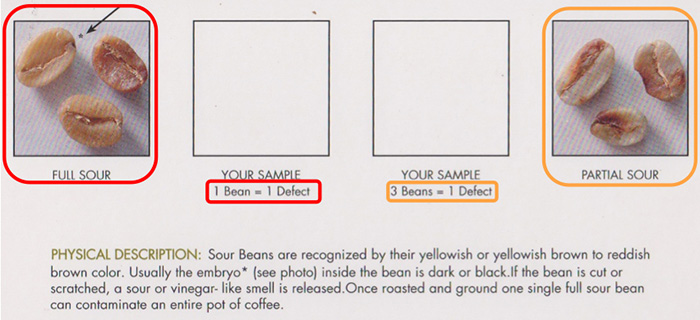
[sour beans]
physical characteristics: the appearance color of sour beans is similar to yellowish brown or reddish brown. It is usually black at the endosperm point (where the arrow points), and the sour smell of acetic acid can be smelled when the beans are cut;
Classification and defect score: sour beans are divided into two categories: total sour beans and local sour beans, the difference method is similar to black beans, if less than half of the beans belong to local sour beans, otherwise they are all sour beans.
1 whole sour bean is a class I
3 local sour beans can be regarded as an II defect .
Effect in the cup: overfermented sour taste (nausea).
Cause: the main cause of sour bean is excessive fermentation. If the environment around the coffee is relatively humid, the ripe coffee fruit will ferment too much if it is not picked in time on the tree; if the picked coffee fruit is stored for too long and not treated in time, it will also be overfermented; the fermentation pool will be dirty in washing, or dirty with water will also cause sour beans; when drying, if the coffee fruit dries slowly, coupled with improper stacking, it will also cause excessive fermentation of coffee fruit and form sour beans.
Avoid and improve:
Planting: in planting, you can stop harvesting coffee fruits that have fallen on the ground by harvesting ripe fruits (avoiding over-ripe coffee fruits), and do not grow coffee at low latitudes near water sources such as rivers, lakes or reservoirs.
Treatment: timely treatment of the picked coffee fruit to avoid excessive fermentation in storage; soaking time in the fermentation tank should be reasonably controlled; water in the washing process should be changed in time to avoid recycling; the drying process should be reasonably controlled; most sour beans can be removed by hand and color selection.
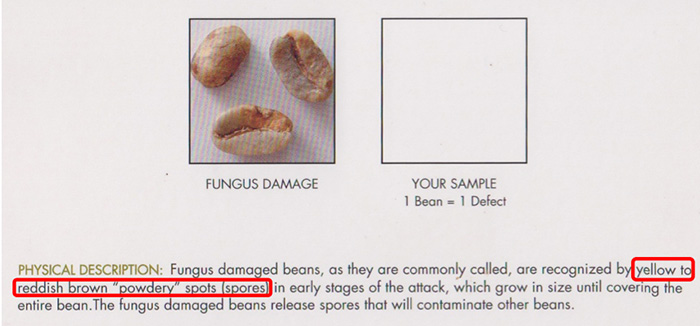
[mildew bean]
physical characteristics: the color of moldy beans is a bit like sour beans, yellow or reddish brown, but an obvious difference is that moldy beans will have a small dent, a little white powder in the spot, these powders are mold spores, very easy to interfere with other raw beans.
Classification and defect score:
One moldy bean counts as a Class I defect.
Influence in the cup: moldy soil flavor, phenolic flavor. Personal feeling is similar to black beans, the taste of miscellaneous soil in the mouth is more obvious, similar to eating a bad fried melon seed, the mouth has an obvious sense of rough gravel and bitter taste. Like black beans, there is a risk of the physiological virus of octreotide A.
Cause: moldy beans may be caused by planting and post-treatment. The mold that causes moldy beans may breed and infect raw coffee beans under certain temperature and humidity conditions.
Avoid and improve:
Planting: the premise of mold growth of moldy beans is spores, and limiting spore production is the key to avoid mold growth. In planting, avoid harvesting coffee fruits that fall to the ground, and avoid leaving raw coffee beans in harvest baskets and drying cylinders.
Treatment: raw coffee beans cut in the process of pulp (skin) removal are more likely to be infected with mold, improper fermentation control, drying is not timely or drying halfway to stop or drying cycle lengthening and other inappropriate treatment methods will make raw coffee beans have a chance to be infected with mold. In addition, shell beans are more likely to be infected with mold if they are stored at higher temperature and humidity. Therefore, the production of moldy beans can be avoided to a great extent by properly adjusting the treatment and storage methods. Color selection can remove most of the serious moldy beans, while mild moldy beans must be selected by hand to effectively remove them.
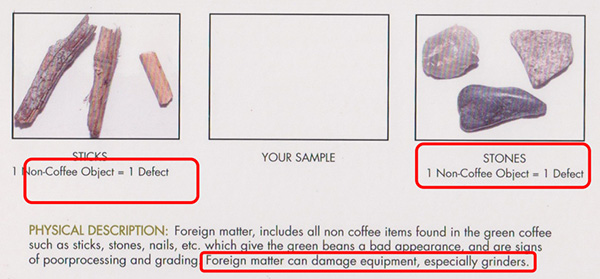
[foreign impurities]
physical characteristics: if it is a large volume of foreign objects are relatively easy to identify from the appearance, but such as pebbles are generally difficult to quickly identify from raw beans, only with the help of auxiliary equipment to remove impurities to avoid the risk of impact on the baking machine and bean grinder.
Classification and defect score:
A foreign object counts as a Class I defect.
Influence in the cup: some foreign substances will affect the raw beans and cause the defective taste in the cup.
Other effects: the more direct impact of foreign objects is on roasters (rollers) and bean grinders (cutters), such as pebbles.
Cause: foreign matter (mostly due to man-made reasons) may be introduced into beans at all stages of the processing process.
Avoid and improve:
In the treatment stage, we should pay attention to avoid introducing sundries such as small stones and branches when picking; when drying naturally on the scaffolding, we should also be careful to avoid introducing foreign objects such as stones, wood strips, and so on; in the process of removing shells after drying, use a stone removal machine, magnets can effectively remove stones, metals and other foreign objects.
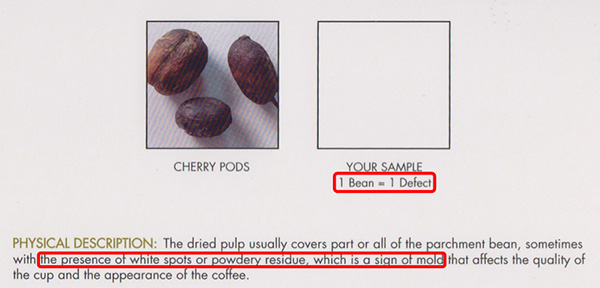
[dried pods]
physical characteristics: large dried pods are generally the whole coffee fruit that is not removed from raw beans after drying, which is much larger than raw beans, and the appearance color will be yellowish brown to dark red; and if dried or improper conditions during storage and transportation, it will be more likely to infect mold and affect other raw beans.
Classification and defect score:
A dried pod counts as a Class I defect .
Effects in the cup: fermentation, mildew and phenolic flavor.
Cause:
Treatment: during washing, the peel is removed improperly (the peeling machine is improperly set up or the aging machine makes the dried pods pass directly), or the floating dried pods are not removed in the first step of rinsing. During sun treatment, improper shelling and screening also have the chance to miss some dried pods.
Planting: drought and disease can dry the coffee fruit on the tree and eventually fall to the ground.
Avoid and improve:
Planting: avoid picking dried coffee fruits that fall to the ground, and avoid picking dried coffee fruits from trees.
Treatment: avoid too many dried pods mixed with raw beans to shell together, because too many dried pods will also cause the sheller to be unable to effectively handle the dried coffee, thus missing part of the dried pods; the floating beans should be completely removed at the beginning of washing. Regular correction and maintenance of peeling machine to effectively remove peels and dried pods. The missing dried pods can be removed by weighing machine in the process of shelling after drying.
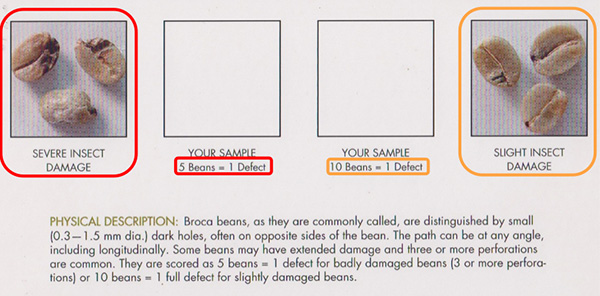
[worm-eaten beans]
physical characteristics: borer beans will be found on the appearance of small holes (diameter 0.3-1.5 mm), and because worms drill in and out will usually have holes on both sides, serious wormholes sometimes several small holes linked together, and like broken beans because the bean body is damaged, it is easy to oxidize in the worm-eaten area and become infected with mold.
Classification and defect score: serious and slight moth-eaten.
Serious wormeaten: there are 3 or more wormholes in the bean body, which is a Class I defect when there are 5 serious wormeaten beans.
Light wormeaten: less than 3 wormholes in the bean body, which is considered an II defect when there are 10 slight wormeaten beans.
Influence in the cup: dirty taste, sour taste, phenolic taste and musty taste.
Cause: worm-eaten beans are produced in the process of planting. The coffee beetle will drill into the coffee beans to lay eggs, and then the eggs will parasitize in the coffee beans and absorb the nutrients of the coffee beans. Wormholes in wormeaten beans usually appear in pairs (in and out).
Avoid and improve:
Planting: be careful in disease and pest quarantine and eliminate all conditions beneficial to coffee beetles as soon as possible; drug spraying is also a way, but the effect is limited. At present, more producing areas use new technologies, such as traps and natural enemies of coffee beetles, to kill pests more effectively. Because the coffee beetle is inside the coffee bean fruit and coffee beans, coffee farmers are unable to distinguish between worm-eaten coffee fruit and normal coffee fruit when picking. The increase of planting altitude will significantly reduce the effect of coffee beetles.
Treatment: moth-eaten coffee beans can be clearly identified after shelling. Most of the serious worm-eaten beans can be eliminated by weighing machine. If the worm-eaten infection is more serious, it must be eliminated by hand.
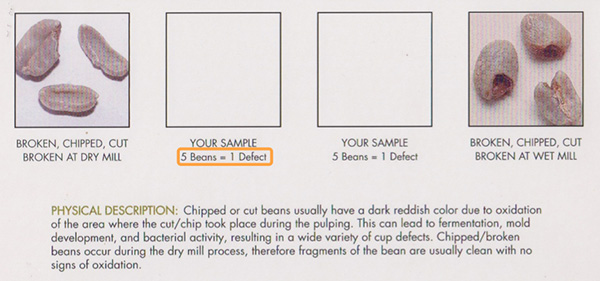
[damaged beans and cut beans]
Physical characteristics of : the appearance of raw beans shows mechanical damage wounds such as rupture and fragmentation, and sometimes the edges show black .
Classification and defect scoring
Five broken beans are counted as an II defect.
Effect in the cup: if there is mildew, there is obvious soil mildew, dirty taste, sour taste and fermented taste.
Cause: improper training of peeling machine or shelling machine in the process of treatment leads to extrusion injury or cut of beans.
When washing, the crushed mouth injured in the peel removal process is more likely to be infected with mold and oxidation, generally turning dark reddish brown or black.
Sun treatment of the broken mouth is generally caused by the shelling of dried fruit, generally relatively clean without signs of oxidation.
Avoid and improve:
Planting: avoid picking unripe coffee fruits.
Treatment: carefully train the peeling machine and sheller; small broken beans can be removed by weight machine and screen, while large broken beans can be removed by color selection and hand selection.
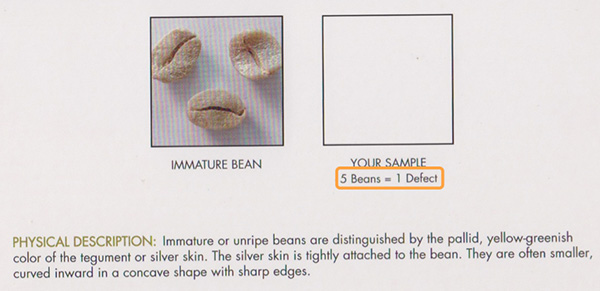
[uncooked beans]
Physical characteristics of : the remarkable feature of unripe beans is that the silver skins are tightly attached. Unripe beans are usually smaller than normal raw beans, with concave bodies and sharp edges. Another name for unripe beans is QUAKER in roasted coffee beans, because raw coffee beans are not fully ripe, resulting in inadequate absorption of sugar, so the caramelization (coloring) during baking is not sufficient, resulting in a much lighter color than normal beans.
Classification and defect score: 5 unripe beans are counted as one II defect.
Influence in the cup: grass flavor, straw flavor.
Cause: unripe beans are produced in the process of planting, such as improper picking and planting late-ripening coffee varieties at high altitudes.
Avoid and improve:
Planting: improve the picking quality, pick only ripe beans, and plant suitable mature varieties according to altitude.
Treatment: because the flesh (skin) of unripe beans binds to coffee beans more closely than normal mature coffee fruits, so in peeling, only a small part of the peel of immature beans will be removed, and even the whole coffee fruit will be omitted. Immaturity can be removed quickly through a sieve. After drying, the unripe beans can also be removed by the weighing machine; it should be noted that because there is no obvious difference between the unripe beans and the normal raw beans in color, it can not be removed with the color sorter.
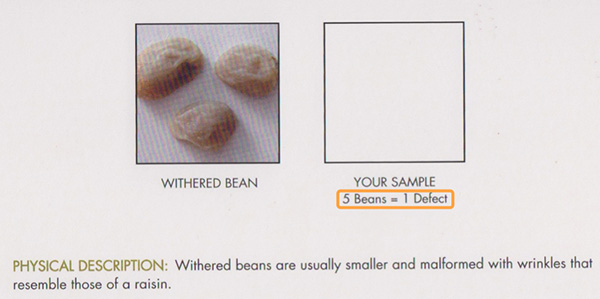
[Shrunken Bean]
Physical characteristics: Shrunken beans are smaller than normal beans, and the most prominent is the dehydrated kind of wrinkles, similar to raisins (can be associated with the hands soaked in water for a long time, the skin wrinkles)
Classification and defect scoring: 5 atrophied beans count as a Class II defect.
Medium effects: slight grassy, straw notes.
Cause: Shrunken beans are only produced during planting, mostly due to drought, which causes coffee trees to develop poorly and fail to deliver nutrients needed for coffee fruit.
Avoid and improve:
Planting: Proper fertilization ensures healthy growth of coffee trees; too many or inappropriate shade trees may compete with coffee trees for water.
Treatment: severely atrophied beans are light in texture and float directly on the water surface during washing, making it easier to remove them; most of the residual atrophied beans can be removed with a specific gravity machine during shelling, and individual large or thick atrophied beans have to be removed by hand.
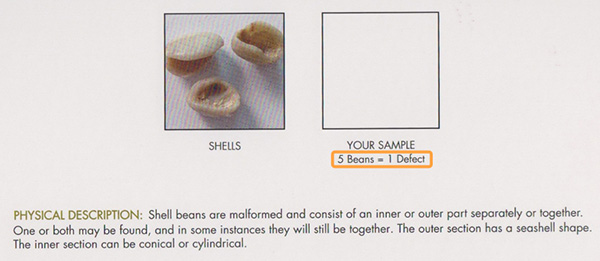
[shell beans]
physical characteristics: shell beans have two parts, the outer part is commonly known as "shell" shape, and the inner part is either tapered or cylindrical. Sometimes, the two parts of the shell beans in the raw beans are still closely attached to each other, which is regarded as one shell bean, or two if they have been separated. Most shell beans are separated into two parts after baking, and the lighter shell on the outside is more likely to be scorched.
Classification and defect score: 5 shell beans are counted as one II defect.
Influence in the cup: choky taste (due to the low density of shell beans, it is very easy to be scorched or even burned by high temperature during baking)
Cause of formation: it is now believed that shell beans are mostly caused by variety genes.
Avoid and improve:
Planting: choose the right variety of coffee to plant and optimize the planting conditions.
Treatment: when shelling, use the weight machine to remove shell beans.
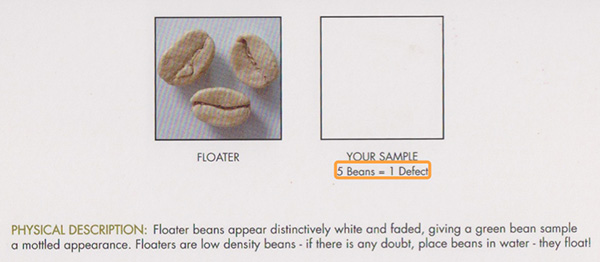
[floating bean]
Physical characteristics: floating beans are much lighter and whiter than normal beans, and they float when they are put in water.
Classification and defect score: 5 floating beans are counted as one II defect.
Influence in the cup: according to the degree, there are fermentation flavor, green grass flavor, straw flavor, soil flavor, mildew taste and so on.
Cause: improper storage and drying are the main causes of floating beans. Shell beans usually lead to floating beans if they are left in a dryer or on a drying scaffolding. Storage with shell beans and an environment with high humidity can also cause floating beans.
Avoid and improve:
Treatment: shelled beans must be evenly dried to a certain water content, so that the production of floating beans can be avoided. After shelling, low-density floating beans can be removed by weight machine, while high-density floating beans have little difference in weight between normal beans and normal beans, so can only be removed by color selection or hand selection.
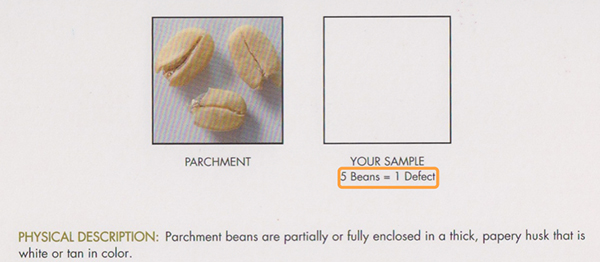
[with shell beans]
physical characteristics: shell beans are generally completely or partially covered with parchment shell, the appearance (shell) color is khaki.
Classification and defect score: 5 shelled beans are counted as one II defect.
Influence in the cup: woodiness. (if there is a large proportion of shell beans, the woody flavor will be obvious.)
Cause: mainly in the process of peeling after drying, if the peeling machine aging or improper training will cause shelled beans to leak.
Avoid and improve:
Treatment: check and correct the sheller before shelling. Separated bean shells (parchment) can be removed by a weight machine.
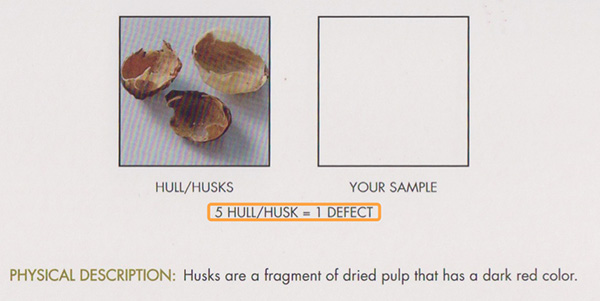
[peel and shell]
Physical characteristics: the peel or shell usually appears as fragments in raw beans, and the appearance color is black-red (like dried raisins) .
Classification and defect score: 5 pericarp (shell, or exocarp) is counted as an II defect.
Effect in the cup: if the pericarp is infected by mold in the cup, it will have a dirty, earthy, moldy, fermented or phenolic taste.
Cause: mainly in the treatment stage, the lack of careful cleaning of raw beans after shelling will lead to residual shells. If the peeling machine is not properly adjusted in the process of peeling in water washing treatment, it will also cause the peel to be broken and eventually become shell fragments after drying.
Avoid and improve: train the peeling machine; pay attention to the process of wind selection and specific gravity selection, do not miss the fruit shell.
Important Notice :
前街咖啡 FrontStreet Coffee has moved to new addredd:
FrontStreet Coffee Address: 315,Donghua East Road,GuangZhou
Tel:020 38364473
- Prev
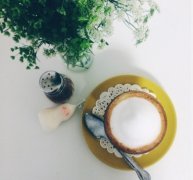
The Common sense of Coffee beans correctly using Q Grader to Grade Coffee
In the Q Grader course (a professional coffee bean grading course), I found that people can't be 100% objective when grading coffee beans. Everyone's experience of coffee is different, because we have different taste buds, different noses and different brains, so we can't judge the taste of coffee objectively. For example, when I have a drink
- Next

Coffee machine common sense how to adjust the Italian coffee grinder
It's a good choice to use an Italian coffee grinder in a coffee shop or at home. As long as you set the right data, you will have an unprecedented coffee experience, and the coffee you make will have constant quality and perfect taste. How to set up an electronic grinder when using a new variety of coffee beans, and how to maintain the constant quality of coffee. In the meantime, I will teach you how to
Related
- Beginners will see the "Coffee pull flower" guide!
- What is the difference between ice blog purified milk and ordinary milk coffee?
- Why is the Philippines the largest producer of crops in Liberia?
- For coffee extraction, should the fine powder be retained?
- How does extracted espresso fill pressed powder? How much strength does it take to press the powder?
- How to make jasmine cold extract coffee? Is the jasmine + latte good?
- Will this little toy really make the coffee taste better? How does Lily Drip affect coffee extraction?
- Will the action of slapping the filter cup also affect coffee extraction?
- What's the difference between powder-to-water ratio and powder-to-liquid ratio?
- What is the Ethiopian local species? What does it have to do with Heirloom native species?

